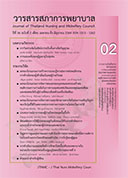Impact of Individual and Family Self-Management Programme on Hemodialysis-Treated Patients’ Adherence to Phosphorus Control and on Their Calcium x Phosphorus Product
Keywords:
individual and family, self-management programme, adherence, phosphorus control, calcium x phosphorus product, hemodialysis patientsAbstract
Objective: To examine the impact of an individual and family self-management programme on patients treated with hemodialysis in terms of their adherence to phosphorus control and their calcium x phosphorus product
Design: Two-group quasi-experimental research with repeated measurements
Methodology: The sample consisted of 59 patients treated with hemodialysis and a
phosphate-binding medication at a tertiary hospital. Twenty-nine of the patients were assigned to the experimental group and 30 into the control group. The experimental group participated in an individual and family self-management programme developed based on Ryan & Sawin’s (2014) Individual and Family Self-Management Theory. The programme was administered in three stages: 1) knowledge and belief building; 2) improvement of skills and self-regulation ability; and 3) social facilitation. The instruments for data collection consisted of: 1) a demographic questionnaire; 2) a questionnaire on the history of illness and hemodialysis; 3) a questionnaire on phosphorus control behaviour; and 4) a clinical outcome record form. The data were analysed using descriptive statistics, chi-square tests, and the repeated measures ANOVA.
Results: The experimental group’s mean post-intervention score on adherence to phosphorus control was significantly higher than its pre-intervention score, and also significantly higher than that of the control groups as measured in weeks 4, 6, and 8. Moreover, the experimental group’s ratio of patients with < 55 mg2/dl2 calcium x phosphorus products was significantly higher than that of the control group (p < 0.5).
Recommendations: It is recommended that nurses apply this individual and family
self-management programme to treating hemodialysis patients in order to promote phosphorus control behaviour and reduce calcium x phosphorus products.
Downloads
References
Kochasenee P, Jittinan A. Chronic kidney disease and initiation of dialysis. In: Kochasenee P, Chanchairujira T, Trakanwanich T, Pajareya T, Vareesangthip K, editors. Essential in hemodialysis. Bangkok: Text and Journal publication Co., Ltd.; 2014. p. 1-17.
(in Thai)
Thammasat University Hospital. Patient service statistic. Pathumthani: Thammasat University Hospital; 2019. (in Thai)
Satirapoj B, Supphasin U.Electrolyte imbalance in hemodialysis patients. In: Thanakitcharu P, Vanichakarn S, editors. Textbook for hemodialysis and nursing. 2nd ed. Bangkok: Bangkok Wetchasan; 2012. p. 259. (in Thai)
Sutheechai S, Sudchada P. Mineral and bone disorder in chronic kidney disease. Srinagarind Medical Journal 2012;27. 417 (in Thai)
Trakanwanich T, Kurathong S. Acute complication of hemodialysis. In: Kochasenee P, Chanchairujira T, Trakanwanich T, Pajareya T, Vareesangthip K, editors. Essential in hemodialysis. Bangkok: Text and Journal publication Co., Ltd.; 2014. p. 241-2. (in Thai)
The Nephrology Society of Thailand. Hemodialysis clinical practice recommendation 2014: maintenance of mineral and bone metabolic disorder. Bangkok: Bangkok Wetchasan; 2014. (in Thai)
Kidney Disease Improving Global Outcomes; KDIGO. Clinical practice guideline update for the diagnosis, evaluation, prevention, and treatment of chronic kidney disease-mineral and bone disoreder (CKD-MBD) [Internet]. 2017 [Cited 2019 Nov 11]; Available from:https://www.CKD-Mineral and Bone Disorder(CKD-MBD) – KDIGO
Kiattisunthorn K. Abnormal bone and mineral metabolism in hemodilysis patients. In: Kochasenee P, Chanchairujira T, Trakanwanich T, Pajareya T, Vareesangthip K, editors.
Essential in hemodialysis. Bangkok: Text and Journal publication Co., Ltd.; 2014. p. 308-28. (in Thai)
Umeukeje EM, Mixon AS, Cavanaugh KL. Phosphatecontrol adherence in hemodialysis patients: current perspectives. Patient Prefer Adherence 2018; 12: 1175-91.
Martins MT, Silva LF, Kraychete A, Reis D, Dias L, Schnitman G, et al. Potentially modifiable factors associated with non-adherence to phosphate binder use in patients on hemodialysis. BMC Nephrol 2013; 14: 208.
Lins SMdSB, Leite JL, Godoy Sd, Tavares JMAB, Rocha RG, Silva FVCe. Atitude of patients with chronic kidney disease on hemodialysis to the established treatment. Acta Paul Enferm 2018; 31: 54-60.
Kongkaew C. Patients’ medication taking behaviours: Critiques of relevant terminologies. Thai Pharmaceutical and Health Science Journal 2011; 6(4): 301. (in Thai)
Elliott JO, Ortman C, Almaani S, Lee YH, Jordan K. Understanding the associations between modifying factors, individual health beliefs, and hemodialysis patients’ adherence to a low-phosphorus diet. J Rent Nutr 2015; 25(2): 111-20.
Jintana P, Sriyuktasuth A, Pongthavornkamol K, Nata N. Information-motivation-behavior skills program improved phosphate binder adherence in patients with
chronic hemodialysis. Nursing Science Journal of Thailand 2016; 34(2): 92-101. (in Thai)
Shi YX, Fan XY, Han HJ, Wu QX, Di HJ, Hou YH, et al. Effectiveness of a nurse-led intensive educational programme on chronic kidney failure patients with hyperphosphataemia: randomised controlled trial. J Clin Nurs 2013; 22(7-8): 1189-97.
Ryan P, Sawin KJ. Individual and family self-management Theory [Revised Figure] [Internet]. 2014 [Cited 2020 Jan 14]; Available from: http://www4.uwm.
edu/nursing/about/ centers-institutes/self-management/ theory.cfm
Rungprai T, Choowattanapakorn T. The effect of an individual and family self-management program on volume overload in older persons with chronic kidney disease undergoing hemodialysis. Journal of Nursing Science Chulalongkorn University 2018; 30(1): 96-107. (in Thai)
Klaypikun K, Choowattanapakorn T. The effect of the individual and family self management program on bowel preparation behavior for colonoscopy in
older persons. HCU Journal of Health Science 2018; 21(42): 123-34. (in Thai)
Surawong S, Choowattanapakorn T. The effect of an individual and family self-management program on HbA1c in older persons with type 2 diabetes mellitus.
Journal of Nursing Science Chulalongkorn University 2017; 29(1): 104-16. (in Thai)
Cohen J. Statistical power analysis for the behavioral sciences. 2nd ed. Hillsdale (NJ): Lawrence Erlbaum Associates, Publishers; 1988.
Srisatidnarakul B. The methodology in nursing research. 5th ed. Bangkok: U & I; 2010. (in Thai)
Cherdrungsri Y. Development of phosphorus counting booklet for hemodialysis patients [thesis]. Nakhon Pathom: Mahidol Univ.; 2013.
Bloom BS. Taxonomy of education. New York: David McKay Company; 1975.
Bandura A. Social foundations of thought and action: a social cognitive theory. New Jersey: Prentice Hall; 1986.
Karavetian M, Ghaddar S. Nutritional education for the management of osteodystrophy (nemo) in patients on haemodialysis: a randomised controlled trial. J
Ren Care 2013; 39(1): 19-30.
Wothawee O. Fators promoting health behaviors among the elderly in ditrict of bang phae, Ratchaburi province [thesis]. Nakhon Pathom: Silapakorn Univ.;
(in Thai)








